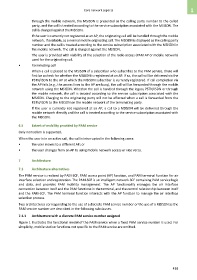Page 449 - 5G Basics - Core Network Aspects
P. 449
Core network aspects 1
through the mobile network, the MSISDN is presented as the calling party number to the called
party, and the call is treated according to the service subscription associated with the MSISDN. The
call is charged against the MSISDN.
If the user is currently not registered at an AP, the originating call will be handled through the mobile
network, if available, as a normal mobile originating call. The MSISDN is displayed as the calling party
number and the call is treated according to the service subscription associated with the MSISDN in
the mobile network. The call is charged against the MSISDN.
The user is provided with visibility of the selection of the radio access (PAM AP or mobile network)
used for the originating call.
• Terminating call
When a call is placed to the MSISDN of a subscriber who subscribes to the PAM service, there will
first be a check for whether the MSISDN is registered at an AP. If so, the call will be delivered via the
PSTN/ISDN to the AP at which the MSISDN subscriber is currently registered. If call completion via
the AP fails (e.g., the access lines to the AP are busy), the call will be forwarded through the mobile
network using the MSISDN. Whether the call is handled through the legacy PSTN/ISDN or through
the mobile network, the call is treated according to the service subscription associated with the
MSISDN. Charging to the originating party will not be affected when a call is forwarded from the
PSTN/ISDN to the MSISDN on the mobile network of the terminating party.
If the user is currently not registered at an AP, a call to a MSISDN will be delivered through the
mobile network directly and the call is treated according to the service subscription associated with
the MSISDN.
6.5 Extent of mobility provided by PAM service
Only nomadism is supported.
When the user is in an active call, the call is interrupted in the following cases:
• the user moves to a different AP; or
• the user changes from an AP to using mobile network access or vice versa.
7 Architecture
7.1 Architecture alternatives
The PAM service is realized by PAM-SCF, PAM access point (AP) function, and PAM terminal function for air
interface selection and registration. The PAM-SCF is an intelligent network SCF containing PAM service logic
and data, and provides PAM mobility management. The AP functionality manages the air interface
connection between itself and the PAM functions in the terminal, and the control relationship between itself
and the PAM-SCF. The PAM terminal function interacts with the AP function to manage the air interface
selection process.
Two architectures corresponding to the use of a discrete PAM service number or the use of a MSISDN as the
PAM service number are described in the following subclauses.
7.1.1 Architecture with a discrete PAM service number assigned
Figure 1 illustrates the functional model of the PAM service when a fixed PAM service number is used. For
simplicity, mobile station functions not specific to the PAM service are omitted.
439

